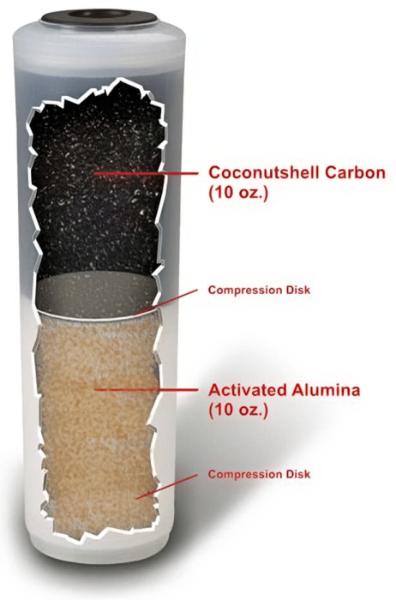What is Fluoride?
Fluorine is a naturally occurring element on the periodic table – atomic number 9. Fluoride is an inorganic monatomic anion of fluorine, with a chemical formula of (F-). When combined with a hydrogen proton, hydrogen fluoride (F2H2) is created. There are three primary types of Fluoride additives used in community water systems: Fluorosilicic acid, sodium fluorosilicate, and sodium fluoride.
Low levels of fluoride ions are naturally occurring in both fresh and saltwater (.86 to 1.4 mg/L) sources, as well as rain water. Some 50 million people worldwide receive water from natural supplies that have an amount of fluoride many experts consider desirable: 0.7-1.2 ppm.
When present in the soil, vegetation contains some amount of fluoride which is absorbed by water in the soil. Mature plant leaves tend to contain concentrated amounts up to 10-20 times that of adolescents. Tea is a naturally rich source of Fluoride, and can contain anywhere between 0.07 to 1.5mg per cup (see estimation of fluoride concentration in tea ); but in fruits such as apples and vegetables like asparagus, fluoride is found in much lower quantities of about 0.01mg per serving.


History of Fluoride in Drinking Water Supplies
Fluoride first became a topic of concern around 1901, after a dental school graduate – Frederick McKay - moved to Colorado Springs, Colorado to open a private practice. Upon arriving, McKay found many of the local residents suffering from dark brown stains on their teeth, resembling chocolate. Concerned, McKay begin searching for a possible cause.
Eventually, with the assistance of a local Doctor, McKay found that 90% of the children in Colorado Springs suffered from the staining – called mottling, which would later be called fluorosis. While the two could not find the root cause of the brown discoloration, they did note anti-cavity effects of the staining.
Several years later in 1923, McKay investigated another issue with mottling in the near-by town of Oakley. McKay would later conclude that the staining was being caused by something in the water delivered from a warm spring five miles outside of Oakley (see: The Story of Fluoridation). After switching to an alternative water spring, the brown staining dissipated in a few short years.
A chemist by the name of H.V. Churchill was the first to perform a water analysis in Bauxite, Arkansas within the vicinity of an aluminum plant; the residents there suffered from the same “chocolate” teeth discoloration. Churchill found high levels of fluoride in the water at Bauxite, and he would later write a five-page letter to McKay detailing his findings, and recommend that McKay collect water samples from area where the dental issues (discoloration of the teeth) were being reported. Sometime after, McKay would find the answer to the brown staining to be caused by increased amounts of fluoride in the water.
After studying Churchill’s and McKay’s findings, McKay concluded that high amounts of water-borne fluoride were the primary causes of teeth staining. A senior chemist at the NIH would later develop an accurate method for measuring low levels of fluoride down to 0.1 ppm, which would help reach more concise conclusion regarding fluoride and teeth staining. Nowadays, the CDC recommends that children drink water from other sources when natural fluoride levels in the water exceed 2pm.
Fluoride Today
After the NIH concluded that fluoride in low quantities of was beneficial for preventing cavities – in line with the findings of McKay – community water fluoridation (predominately hydro fluorosilicate) became popular. Its low entry cost – around $1 per person yearly – is a great selling point for local governments. Fluoride was first used in the U.S. at the municipal level in Grand Rapids, MI by the year 1945; the optimal range of fluoride in the water for preventing tooth decay is 0.7, a number reached after years of scientific study. In 2008, more than 72% of the U.S. population served by public/city systems has access to fluoridated water.
Currently, there are 54,000 community water systems in the United States, 18,400 (subject to update – WFRS database) of which provide fluoridated water. The District of Columbia is currently ranked #1 on the list of states with 100% (2018 statistic) of its communities’ serving fluoride in their water. On the opposite side of the spectrum stands New Jersey, which currently fluoridates less than 20% of its municipal water. Comparatively, fluoridation in western Europe is not a standard practice, with around 3% of the population consuming fluoridated water.
Find out how much fluoride is in your city/state water here


Fluoride and Your Health
Fluoride in small doses does prevent tooth decay – a goal which can be achieved by applying fluoride topically. Often, you’ll find fluoride in toothpaste, and mouthwash, and is intended for protecting tooth enamel only. Beyond your teeth, Fluoride use has little to no positive impact in our diets (see: is fluoride an essential nutrient). The majority of concern, such as somatization and skeletal fluorosis, involving fluoride comes through its consumption during adolescent stages of life. From birth to ages 1-3yrs, the daily recommended intake of fluoride is < 1mg. Adults have a higher tolerance, which make them less prone to the negative side-effects.
Fluoride is a naturally occurring mineral, and when added to the water, it ends up in almost all processed foods and beverages, fruits, and vegetables. Even if your community water treatment centers do not add it, you’re still likely consuming it, albeit in smaller quantities.
In an environment where fluoride is extremely hard to avoid, ensuring your fluoride levels stay inside the optimal range becomes difficult – and very hard to track. Even if you’re aware of the exact levels of fluoride in your tap water There’s no way to tell how fluoride derived from your diet will affect your daily intake totals – which results in unknown bodily concentration. For example: those who drink tea instead of coffee in the mornings and evenings (found to contain up to 1.5mg per cup) and nothing but bottled water (with fluoride added: 0.19 to 0.24mg/per serving) risk high levels of exposure.


The Dangers of Fluoride
There are several scenarios where fluoride can be dangerous:
- Skeletal Fluorosis from excessive fluoride exposure
- May interfere with sexual development in adolescents at levels between .31 and .59 mg/L.
- Can cause damage to the brain and central nervous system in children in quantities as low as 0.88mg/L.
Skeletal Fluorosis
Extended periods of excessive fluoride exposure can cause a bone disease known as skeletal fluorosis. This disease can be hard to distinguish when compared side-by-side to other bone diseases, although research (see: Skeletal Fluorosis & Individual Variability) shows that it typically occurs when patients surpass the safety thresholds of fluoride:
1) daily dose 10 or 20mg
2) water fluoride content < than 4 or 8mg/L
3) bone fluoride content is < than 6,000ppm
4) urinary fluoride content is < than 5ppm
5) blood fluoride content is < than 95ppb
In cases where maximum fluoride consumption thresholds are surpassed, often for prolonged periods of time (10-30 years, except in cases prior to adolescence where symptoms can occur rapidly), brittle bone syndrome has been noted in several studies such as, the Department of Orthopedics Study on Crippling in Skeletal Fluorosis, and causes visible deformation of the bone such as: bowed legs and arms, outward curve of the upper spine, scoliosis (abnormal curvature of the whole spine), and loose joints.
Residents of some parts of India have been placed in a particularly high-risk group for bone diseases like skeletal fluorosis, due to abnormally high levels of fluoride in their groundwater. This contamination and excess fluoridation in some if India’s geological locations, where fluoride bearing minerals and volcanic activity account for leaching into the groundwater. Fluoride content in the state’s groundwater is often as high as 7 to 8mg/L, nearly four times the EPA’s recommended daily intake of 0.7 – 1.2mg/L. Unnao and Rae Bareilly districts of Uttar Pradesh show fluoride content up to 15mg/L, and it is in these areas where dental and skeletal fluorosis reports are numerous. On the opposite side of the spectrum, areas like Sonbhadra and Sidhi suffer from a lack of fluoride in the water (less than 1mg/L), which has caused increased cavities in children and adults.
Sexual Development
A 2019 review of fluoride exposure and pubertal development in children living in Mexico, used a cross-sectional study group of 157 boys, and 176 girls between the ages 10-17. Fluoride levels were accurately identified at the individual ion level in the urine, and adjustments were made to account for variance in specific gravity. The health review concluded delayed pubertal development among the boys, and non-significant negative associations with pubertal stages in girls for the same covariates.
The Nutrition and Health Research, National Institute of Public Health (Mexico) also recommends a lowering of the EPA’s maximum contaminant level goal for fluoride (from 4 ppm to 2ppm).


In the brain
For years, health experts have agreed that fluoride in the drinking water may be toxic to the developing human brain. In 2012, a review of developmental fluoride neurotoxicity and meta-analysis was performed. The review cited several studies where negative effects on learning and memory – including effect on IQ, permanent brain damage, and other issues related to exposure on the developing brain.
Characteristics of epidemiological fluoride exposure studies on children confirmed lower IQ levels. In one Chinese test group, children (7-14yrs old) in a high fluoride consumption group (0.88mg/L) were found to have lower IQ scores when compared to a low Fluoride level (0.34mg/L) reference group.
In another analysis group containing older children (7-16), IQ scores were found to be significantly lower in those hydrating from a water source containing 2.1-7.6 mg/L of fluoride vs a reference group containing 0.6 – 1.0 mg/L.
The study suggests an inverse relation between increased levels of fluoride exposure and children’s intelligence. This is of particular concern taking the DHHS recommended fluoride intake of 0.7 – 1.2 mg/L into account, and the EPA’s recommended maximum 4 mg/L.
How to Remove Fluoride from Drinking Water
There are several ways to keep your fluoride levels in check. When the only benefit to fluoride to prevent cavities, then toothpaste or mouthwash containing the substance should be sufficient – but in reality, there is no way to confirm levels as they differ from person to person. Consuming higher than recommended levels (4mg/L) of fluoride over time may cause complications, especially in developing children. And while adults are not as prone to experiencing health issues, fluoride exposure at high levels can still be of concern, causing skeletal fluorosis, brittle bone disease, calcification of the pineal gland, endemic fluorosis, stunted sexual development, and brain damage (see: A Bibliography of Scientific Literature on Fluoride).
Eliminating fluoride through water filtration is the best method for reducing daily intake, and reverse osmosis filtration is by far the best way to accomplish this. Any of the Home Master RO water systems will remove up to 97.7% of
fluoride from common municipal and potable well water systems. A reverse osmosis membrane rejects most dissolved solids from passing through their pores, making it the ideal choice for removing fluoride from cooking and drinking water.
Home Master Jr. F2 countertop systems can also remove fluoride from tap water when used as directed. The Junior series F2 systems contain - activated-alumina - a fluoride specific filtration media - which reduces Fluoride (F2H2) by up to 93% when used as directed.


Fluoride in Summary
Fluoride in small quantities can be beneficial for preventing tooth decay and cavities. Apart from its usefulness in-between visits to the dentist, fluoride is not an essential mineral in humans and has no known benefits to the human body (see also: 2015-2020 dietary guidelines and A Bibliography of Scientific Literature on Fluoride). Fluoride’s prevalence in drinking water (0.7 – 1.2 ppm), oral care products (can boost intake 100 to 1,000-fold – see CDC.gov), and in many of the foods we eat further complicates tracking daily intake levels – which can vary drastically from person to person. Health risks involving fluoride, exist primarily in the early developmental stages (before puberty), and males appear to be at a higher risk from over-exposure than females.
The easiest way to alleviate concerns over excess fluoride consumption, is to first confirm community fluoridation and concentration levels. Then, a simple dietary review can provide a rough estimate of daily intake through foods containing fluoride. A comparison of these totals with daily recommended intake amounts can provide solid grounds on which to make a decision – that is whether or not removing fluoride from your water is necessary to keep absorption levels under the maximum recommended daily intake level. You may find your cause for concern is unjustified or vice versa.


